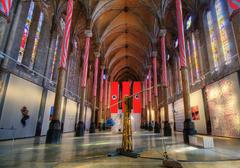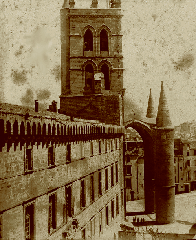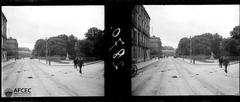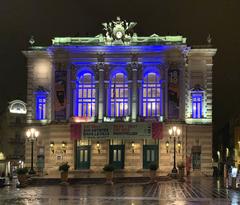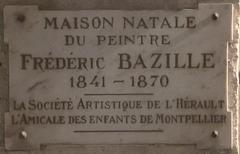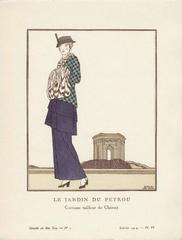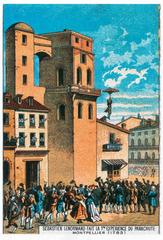
Stade Sabathé Visiting Hours, Tickets, and Guide to Montpellier’s Historic Rugby Stadium
Date: 04/07/2025
Introduction
Stade Sabathé, nestled in the heart of Montpellier, France, is a historic sports venue that embodies the city’s deep-rooted passion for rugby and community life. Inaugurated in 1930 and named in honor of local rugby advocate Jean Sabathé, this iconic stadium stands as a symbol of Montpellier’s sporting heritage, offering a blend of tradition, modern facilities, and cultural vibrancy. Whether you are a rugby fan, a curious traveler, or a local resident, visiting Stade Sabathé provides an authentic window into Montpellier’s dynamic sports culture and its enduring community spirit (Montpellier Méditerranée Métropole, Petit Futé).
This comprehensive guide presents everything you need to know about Stade Sabathé: its history, architectural evolution, visiting hours, ticketing options, accessibility, amenities, and practical tips to enhance your experience. You’ll also find insights into nearby attractions and answers to frequently asked questions to help you make the most of your visit.
Table of Contents
- History and Origins
- Architectural Evolution and Facilities
- Sporting and Cultural Significance
- Visitor Information
- Amenities and Spectator Comfort
- Community Impact and Major Events
- Recent Renovations and Future Outlook
- Nearby Attractions and Travel Tips
- Frequently Asked Questions (FAQ)
- Visuals and Media
- Conclusion and Call to Action
- References
History and Origins
Stade Sabathé’s origins trace back to the early 20th century, a period marked by Montpellier’s urban growth and burgeoning interest in organized sports. The stadium was inaugurated in 1930 as Stade de la Croix Bonhomme, built on land donated by Jean Coll de Carrera, a noted obstetrics professor and rugby supporter. The donation came with the unique stipulation that the grounds remain dedicated to rugby, a tradition that continues today (encommun.montpellier.fr).
In 1944, the venue was renamed Stade Sabathé in honor of Jean Sabathé, a revered local rugby figure who served as captain and coach of Union Sportive Montpelliéraine (USM). Over the decades, the stadium became synonymous with Montpellier rugby, serving as the home ground for USM and later Montpellier Rugby Club, reflecting the evolution of rugby in the region (Wikipedia).
Architectural Evolution and Facilities
Stade Sabathé has undergone several phases of renovation to meet the needs of athletes and fans. From its early days as a modest venue, the stadium expanded its capacity to approximately 6,500–8,000, depending on configuration and event (StadiumDB, Ostadium). The main grandstand is covered, offering shade and shelter, while open stands immerse spectators in the match-day atmosphere.
Recent modernization includes:
- Installation of a state-of-the-art synthetic pitch, enabling year-round use and supporting rugby, American football, and athletics
- Upgraded locker rooms, medical facilities, and referee areas
- Improved lighting systems for evening matches
- Enhanced accessibility features, including ramps and designated seating for visitors with reduced mobility
- Clubhouse and meeting rooms serving as community spaces (encommun.montpellier.fr)
Sporting and Cultural Significance
Stade Sabathé holds a unique position in Montpellier’s vibrant sports landscape. It was the historic home of Montpellier Hérault Rugby until 2007 and remains the base for Montpellier XIII (rugby league) and the city’s elite and youth women’s rugby teams (Montpellier Hérault Rugby). The stadium regularly hosts significant rugby matches, regional tournaments, and training sessions, nurturing local talent and fostering a sense of belonging among sports enthusiasts.
Beyond sports, Stade Sabathé is a central gathering place for cultural events, concerts, festivals, and community celebrations, reinforcing its role as a versatile public space and neighborhood landmark (Ville de Montpellier).
Visitor Information
Visiting Hours
Stade Sabathé is generally open to the public during scheduled matches, events, and training sessions. On non-match days, guided tours may be available by appointment, especially during special events or heritage days. For the most accurate visiting hours, check the official Montpellier Hérault Rugby website, Montpellier Hurricanes venue page, or contact the stadium directly.
Ticketing
Tickets for official matches can be purchased:
- Online via club websites (Montpellier Hérault Rugby, Montpellier Hurricanes)
- At the stadium’s ticket office on event days
Prices are typically affordable, with discounts for children, students, and seniors. Major matches and derbies can sell out, so advance booking is recommended.
Accessibility
Stade Sabathé is equipped for inclusivity:
- Wheelchair access, ramps, and designated seating
- Accessible restrooms
- Trained staff to assist visitors with special needs
- Guide dogs are welcome
For personalized assistance, visitors can contact the stadium or the Montpellier Tourist Office ahead of their visit.
Getting There
- Public Transport: Easily accessible by tram (lines 1, 2, and 4; stops “Gambetta” or “Mas Drevon”) and several bus routes.
- Car: Limited parking is available near the stadium; early arrival is advised on match days.
- Cycling: Dedicated bike racks support eco-friendly travel.
- Taxi/Ride-Sharing: Drop-off points are available close to the entrance.
Amenities and Spectator Comfort
Visitors enjoy a range of amenities designed for a comfortable experience:
- Clean, modern restrooms
- Locker rooms for athletes and officials
- Food and beverage stalls offering snacks, drinks, and local specialties on match days
- Covered stands for shelter and comfort
- Family-friendly atmosphere, welcoming fans of all ages
- Souvenir and merchandise stalls during major events
Community Impact and Major Events
Stade Sabathé is more than a sports venue—it is a community hub that embraces Montpellier’s diverse population. The stadium supports amateur clubs, schools, and associations, hosting community events and promoting women’s sports. Recent renovations included the installation of a synthetic pitch and tributes to women athletes, reinforcing its commitment to progress and inclusivity (actu.fr, encommun.montpellier.fr).
The stadium has hosted notable events, including Top 14 rugby fixtures, French Elite One Championship rugby league matches, and training sessions for international tournaments like the 2007 Rugby World Cup (Rugbyrama).
Recent Renovations and Future Outlook
In 2023, Stade Sabathé underwent significant upgrades:
- New generation synthetic pitch (investment: €1.7 million)
- Renovated stands and locker rooms
- Improved accessibility and spectator amenities
- Visual tributes to Montpellier’s rugby heritage and women athletes
These enhancements ensure the stadium’s continued relevance as both a historic monument and a modern sports facility (montpellier-infos.com).
Nearby Attractions and Travel Tips
While visiting Stade Sabathé, take time to explore nearby Montpellier attractions:
- Place de la Comédie: The city’s vibrant central square
- Musée Fabre: Renowned art museum
- Montpellier historic center: Medieval streets and lively cafés
- Local shops and bakeries: Experience authentic daily life
Combine your match-day with sightseeing for a well-rounded cultural outing.
Frequently Asked Questions (FAQ)
Q: What are the typical visiting hours for Stade Sabathé?
A: The stadium is usually open 1–2 hours before scheduled matches or events. For tours, check with the stadium or the Montpellier Tourist Office.
Q: How can I purchase tickets?
A: Buy online via official team websites or at the stadium’s ticket office on match days.
Q: Is Stade Sabathé accessible for visitors with disabilities?
A: Yes, with ramps, designated seating, accessible restrooms, and staff assistance.
Q: Are guided tours available?
A: Tours may be offered by appointment, especially during special events or heritage days. Contact the stadium or tourist office for details.
Q: What public transport options are available?
A: The stadium is served by tram lines 1, 2, and 4, as well as several bus routes. Cycling and taxi options are also available.
Q: What are some nearby Montpellier historical sites?
A: Explore the historic city center, Place de la Comédie, Musée Fabre, and other local landmarks.
Visuals and Media
Enhance your visit by exploring photo galleries and virtual tours available on club and city websites. High-quality images showcase the stadium’s architecture, match-day atmosphere, and recent renovations (Montpellier Hérault Rugby).
Conclusion and Call to Action
Stade Sabathé is an enduring symbol of Montpellier’s sporting legacy—a place where history, community, and athletic passion unite. Its accessible location, modern amenities, and welcoming atmosphere make it a must-visit for rugby fans and cultural explorers alike. For the latest match schedules, visiting hours, and ticket information, consult official websites and consider combining your visit with exploration of Montpellier’s historic sites.
Stay up to date with events and exclusive content by downloading the Audiala mobile app and following Montpellier’s sports organizations on social media.
References and Further Reading
- Stade Sabathé, Montpellier Méditerranée Métropole
- Stade Sabathé, Petit Futé
- Rugby: Une pelouse synthétique en chantier pour le Stade Sabathé, encommun.montpellier.fr
- Stade Jean Sabathé, Ostadium
- Montpellier Hérault Rugby Official Website
- Ville de Montpellier - Stade Sabathé
- Stade Sabathé, Wikipedia (French)
- Montpellier Hurricanes - Stade Sabathé Venue
- Montpellier Tourist Office - Traveller Information
- Montpellier Infos - Stade Sabathé Renovations
Experience the passion, tradition, and community spirit of Montpellier at Stade Sabathé—where every visit is a celebration of sport and local heritage.

